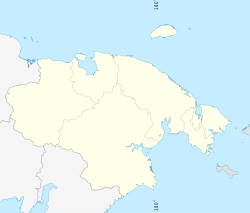Aliskerovo
| Aliskerovo (English) Алискерово (Russian) |
|
|---|---|
| - Inhabited locality - Urban-type settlement (abolished) |
|
 Location of Chukotka Autonomous Okrug in Russia |
|
|
|
|
|
|
|
| Administrative status (as of September 2009) | |
| Country | Russia |
| Federal subject | Chukotka Autonomous Okrug |
| Administrative district | Bilibinsky District |
| Statistics | |
| Population (2002 Census) | 7 inhabitants |
| Population (January 2010 est.) | 1 inhabitants |
| Time zone | PETT (UTC+12:00) |
| Founded | 1961 |
| Abolished | 1998 |
| Postal code(s) | 689450 |
Aliskerovo (Russian: Алискерово) is an inhabited locality (an urban-type settlement) in Bilibinsky District of Chukotka Autonomous Okrug, Russia. Population: 1, a reduction from 7 (2002 Census);1,306 (1989 Census).
The settlement was founded in 1961 and named after Russian geologist Aziz Aliskerov, who played a significant role in the discovery and mapping of natural resources in this part of Russia.
By 1968, the settlement had a population of around 2,300 inhabitants. The mines were declared unprofitable and that there was no possibility of developing any other form of economy in 1999 and the settlement was closed along with a number of others in Chukotka. The Russian government guaranteed funds to transport non-working pensioners and the unemployed in liquidated settlements including Aliskerovo from Chukotka to other parts of Russia. The Ministry of railways was obliged to lease containers for the transportation of the migrants' goods to the Chukotkan administration and ensure that they were delivered to the various settlements. By 1998, however, it was mostly depopulated. As of 2009, Aliskerovo is included in the list of settlements currently in the process of being liquidated.
A meteorite was recovered here on July 10, 1977. The meteorite was discovered in alluvium approximately 200,000 years old. It weighed 58.4 kilograms (129 lb) and was classified by the Natural History Museum as a medium Octahedrite, containing (mineral composition determined by X-ray spectral microanalysis): 9.25% nickel, 0.42% cobalt, and 0.30% phosphorus. Some of its structural features testify to repeated metamorphic influences (impact loads and heating), which occurred during both its extraterrestrial existence and its passage through the atmosphere and fall to Earth including: exhibiting striated kamacite, emulsion-like taenite, and the recrystallization of troilite-daubréelite nodules.
...
Wikipedia

